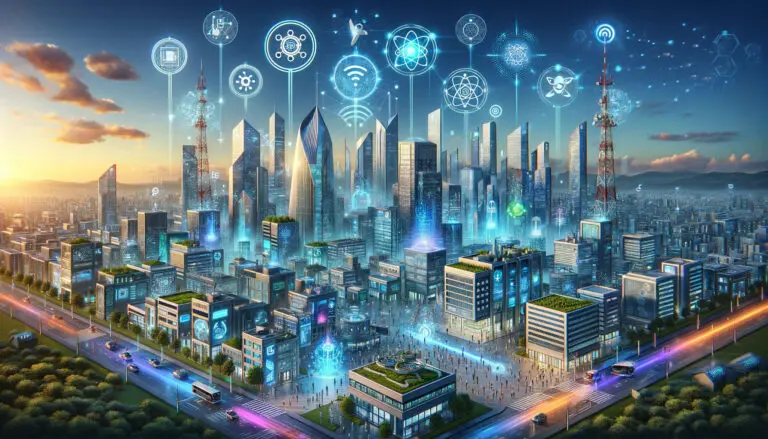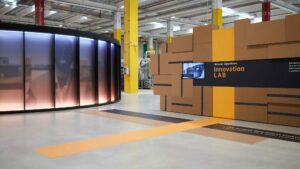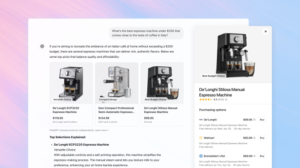These are the tech trends for 2024

At the end of the year, the question arises again and again in all areas of life as to what the next year will be like. We’ve taken a close look at the forecasts for the tech industry and present ten likely trends – based on analyses by major consulting firms Gartner and GP Bullhound.
This piece appeared in the latest Trending Topics magazine “ A Trip to Tomorrow .”
Generative AI – Everyday automation
Generative AI will also dominate as a key trend in 2024. Models like ChatGPT, Bard, and Claude are ushering in a wave of GenAI. By 2026, over 80% of companies are expected to use GenAI APIs, in stark contrast to less than five percent at the start of 2023. This technology is becoming the most influential force in the current tech landscape. 2024 will be crucial to explore the full potential of generative AI, especially with a focus on knowledge democratization and training. Gartner predicts that this development will drive “efficiency, productivity and hyper-personalization.” 2024 marks the turning point at which generative AI not only appeals to technical experts, “but also becomes recognizable to everyone as a transformative force in everyday life.”
More intelligent Apps
Gartner defines intelligence in applications as “learned adaptation to respond appropriately and autonomously,” and it is precisely this ability that enables meaningful additions or automation of work processes. With the rise of generative AI, enterprise apps are going one step further, becoming smarter and “transforming the experience for customers, users, product managers, and developers”. By integrating transactional and external data, intelligent applications aim to provide tailored information, supported by AI-driven predictions and recommendations. This enables better results and data-driven decisions.
Phygital convergence
AR, VR & AI are driving investments in immersive education, especially in medical and high-risk professions. The fusion of the real and the digital is reinforced by technologies such as augmented reality, virtual reality, and immersive experiences, which are intended to blur the boundaries between the worlds. Digital convergence and digital twins show that “the digital is becoming more realistic and the real is becoming more flexible”. These trends will not only accelerate digital skills in various professions but also refine business processes, increase efficiency, and lead to cost-effective solutions. The blurred distinction between reality and virtuality is likely to continue to grow in 2024, present in the world of work, leisure, and innovations such as the digital twin in genomics.
Green technology
Whether GreenTech, CleanTech, or ClimateTech – sustainable technologies are on the rise. In response to the environmental crisis, zero-emission commitments are increasingly being made. Technologies such as AI, blockchain, and augmented reality enable a more environmentally friendly future, if possible without loss of efficiency. 2024 will continue to be dominated by sustainable technologies as countries and companies advance their net zero commitments. Electric cars, bicycles, and public transport are becoming increasingly important. Challenges include ethical material sourcing, infrastructure adjustments, and possible inequalities in access to green alternatives. Vigilance against greenwashing, superficial efforts at positive PR, will increase.
Quantum computing
Groundbreaking data processing technology takes advantage of quantum phenomena such as superposition and entanglement. This enables rapid application areas such as optimized investment strategies, advanced encryption and new product discovery. The key component of this trend is the enormous speed of quantum computers compared to traditional ones. Companies like Microsoft, AWS, and Google are investing heavily in innovation. Global market sales are expected to exceed $2.5 billion by 2029. In 2024, quantum computing will bring tangible benefits, particularly through unique capabilities such as quantum entanglement and superposition. The first investors from the financial sector are hoping for improvements in AI applications, particularly in fraud detection and risk management. While quantum computers won’t speed up every task, benefits are increasingly becoming apparent in computationally intensive areas such as drug discovery, genome sequencing, and traffic flow optimization in major cities. Looking into the future shows great potential for solutions to various challenges, from environmental problems to the search for extraterrestrial life. •
Cyber resilience
Cybersecurity has become a key pillar for businesses as cyberattacks pose a constant threat. Protecting against data breaches requires pragmatic and systematic approaches, including the use of encrypted services, employee training, and penetration testing. The introduction of a “zero trust approach” will be crucial to strictly authenticate access requests and check for anomalies. By the end of 2024, the cost of successful cyberattacks could rise to over $10 trillion. However, cyber resilience goes beyond just cybersecurity and includes measures to recover and ensure business continuity. Automation through artificial intelligence, integrated security measures, and awareness of societal factors will be crucial to cyber resilience strategies.
Data as currency
Data is a crucial corporate asset and can make a difference to the competition. The concept of dating transforms everything into data-driven technology, from smartphones to office applications. A data-driven strategy enables companies to create new customer experiences, accelerate processes, and react flexibly to unforeseen events.
Robotic process automation
RPA automates business processes using artificial intelligence and machine learning. The main advantage is the automation of repetitive tasks, allowing employees to tackle more creative and productive tasks. RPA is intended to save costs, increase profitability, reduce time, and minimize errors. In areas such as finance, customer service, and human resources, it will help capture and store data.
IoT and hyperconnectedness
The Internet of Things, with sensors and connected devices, plays a central role in forming digital twins, building the metaverse, and improving the functionality of intelligent machines. IoT collects and interprets data from industrial machines, increases efficiency, saves production costs, identifies business opportunities, and supports product innovation. With a predicted 50 million IoT devices by 2030, a large network is emerging that offers companies greater security, efficiency, and decision-making ability. From refrigerators to street lamps – IoT is intended to make our everyday lives more comfortable, efficient, and safer.
Progress in 5G expansion
According to analysts, in 2024 the introduction of 5G will fundamentally change the software sector. This technology enables the development of new applications that benefit from fast and reliable connections. With speeds up to 100 times faster than 4G, 5G will revolutionize user experiences in areas such as autonomous driving, augmented and virtual reality, and remote surgery. The low latency and high bandwidth of 5G should not only advance the Internet of Things but also enable transformative advances in healthcare and immersive technologies.





























